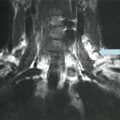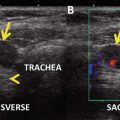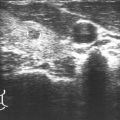© Springer International Publishing Switzerland 2016
David S. Cooper and Cosimo Durante (eds.)Thyroid Cancer10.1007/978-3-319-22401-5_2222. A Case of Papillary Thyroid Cancer Without Aggressive Histological Features with Nodal Metastases Detected During Follow-Up in a Younger Patient
(1)
Department of Medical, Surgical and Neurological Sciences, University of Siena, Siena, Italy
(2)
Policlinico Santa Maria alle Scotte, Viale Bracci 1, 53100 Siena, Italy
Keywords
Thyroid cancerLymph node metastasesRadioiodineNeck ultrasoundThe Case
A 19-year-old woman underwent a total thyroidectomy for a suspicious nodule; final pathology described a 1.4 cm papillary cancer, classical variant, with no extrathyroidal extension. No central neck dissection was performed. After surgery, 30 mCi of radioiodine was administered. The first follow-up visit documented absence of residual disease with undetectable serum Tg and normal neck ultrasound.
During a subsequent follow-up visit (5 years after initial treatment), neck ultrasound showed a 7 × 7 × 9 mm thyroid bed nodule suspicious for recurrent disease; Fine-needle aspiration (FNA) biopsy confirmed the presence of recurrent papillary thyroid cancer. At that time, basal Tg was 1.1 ng/ml, rising to 3.4 ng/ml after recombinant human TSH stimulation. A second course of radioiodine was administered using 150 mCi of 131I. The post-therapy scan showed no uptake in the neck. Her endocrinologist recommended surgery in the near future, and she came to our center to discuss whether this was necessary.
Assessment and Literature Review
In differentiated thyroid cancer, structural tumor recurrences in the post-surgery follow-up occur in about 3 % of cases, and they are not different between low-, intermediate-, and high-risk patients [1, 2]. In the case of cervical lymph node recurrences, the management may include no therapy, compartmental lymph node dissection, radioiodine therapy, ethanol injection, or radiofrequency or laser ablation. The final decision should be made after discussions involving the endocrinologist, the surgeon, and the patient [3]. However, as discussed in the 2009 ATA guidelines , the clinical significance of very small cervical nodal metastases remained to be clarified and no specific recommendation was given [3].
Recent data from retrospective studies have suggested that suspicious but small, stable cervical lymph nodes could be followed with serial ultrasound without intervention. Two recent studies have analyzed the natural history of small thyroid bed nodules or suspicious cervical lymph nodes, demonstrating that cervical lymph nodes and thyroid bed nodules usually remain stable for long periods and could be safely monitored with regular neck ultrasound and biochemical evaluation with Tg measurement [4, 5].
In particular, in a retrospective review of 191 patients with at least one thyroid bed nodule (≤11 mm) over a median follow-up of 5 years, only 9 % of patients had an increase in size of at least one nodule, with a low rate of growth (median 1.3 mm/year) [4]. Suspicious cervical lymph nodes left untreated also revealed a low rate of growth. After a median follow-up of 3.5 years, only 9 % of them (15/166) grew at least 5 mm in the longest diameter, with a rate of growth of 1.5 mm/year with no associated disease-related mortality. Among the fifteen patients, seven underwent FNA biopsy, and cytology was consistent with papillary thyroid cancer in 5 cases [5]. Unfortunately, no prospective and randomized trials with longer follow-up have compared the outcome of recurrent lymph node metastases treated or untreated by surgery.
Stay updated, free articles. Join our Telegram channel

Full access? Get Clinical Tree






